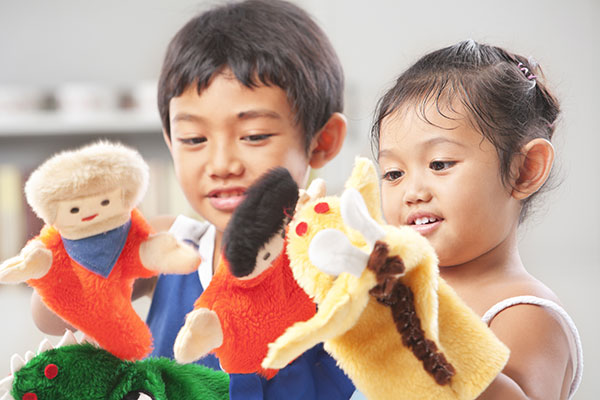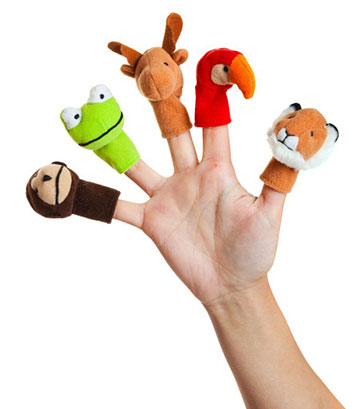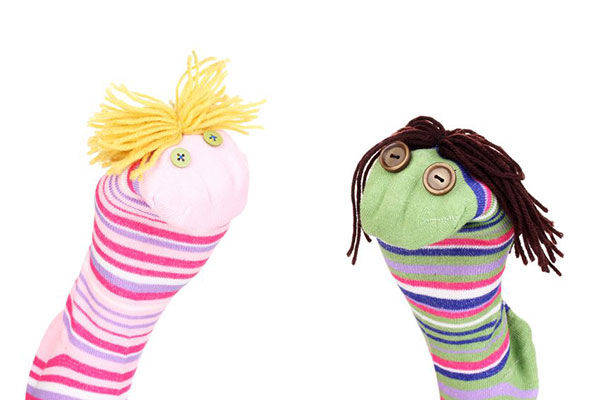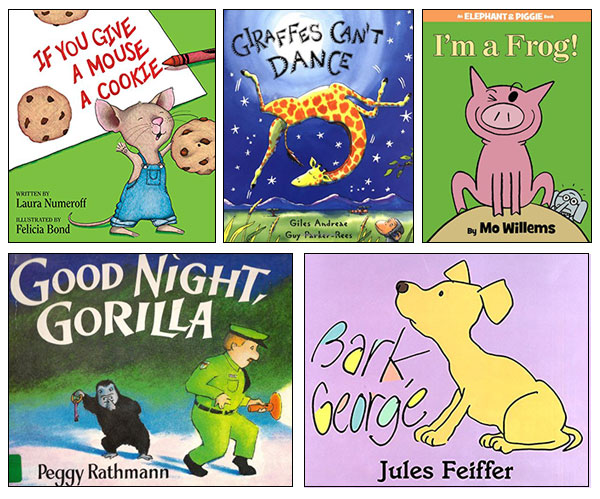Using Puppets to Enhance the Storytime Experience
“Anyone who does anything to help a child in his life is a hero to me. ”
― Fred Rogers

I recently watched Won’t You Be My Neighbor, the new documentary on the life and career of Fred Rogers … Mister Rogers. At the conclusion of the documentary, I reflected on how he shone a light on the role storytelling has in our service to children and families. At the start of every show, Mister Rogers joined the audience at 143, his numerological code for “I love you.” Rogers provided a welcoming environment where every audience member was invited to travel to the Neighborhood of Make-Believe, where the audience met puppet friends Daniel Tiger and Lady Elaine Fairchilde, to name two of them. Each puppet portrayed real feelings and real experiences.
Throughout my experience as a children’s librarian, puppets have been essential tools for connecting with families. Here’s a puppet toolkit to help you bring puppets into your storytime program or to enhance your current work with puppets. This toolkit is based on my experience. Add or edit the toolkit to meet your needs.
The Puppet Toolkit
Tool #1: Puppet Purpose: Think about the purpose a puppet will serve for your storytime program. Some questions to consider:
- Does the puppet align with a theme or does it need to align with a theme?
- Will the puppet help facilitate the program?
- Will you have one or multiple puppets in the program?
- Will you use animal or people puppets?
- Where will you use the puppet in your storytime (at the beginning, middle, end, or throughout the storytime?
 Tool #2: Finding or Creating a Puppet: Search for places to purchase puppets or ideas on how to create a puppet. In doing a simple search, you can find several puppet distributors. Search at community yard sales or a local thrift store. Many of us, including myself, are on tight budgets and it may be difficult to purchase puppets. There are many resources for making puppets. Here are a few to get you started:
Tool #2: Finding or Creating a Puppet: Search for places to purchase puppets or ideas on how to create a puppet. In doing a simple search, you can find several puppet distributors. Search at community yard sales or a local thrift store. Many of us, including myself, are on tight budgets and it may be difficult to purchase puppets. There are many resources for making puppets. Here are a few to get you started:
- A video from Parents Magazine on how to make a sock puppet.
- A puppet craft tutorial from Danielle’s Place
- “Making Homemade Puppets” from Savay Homemade
- A simple Pinterest search.
Tip: Always remember to look in your library supply closet before purchasing. Tell your community about this project and the supplies needed. You might be surprised with donations.
 Tool #3: Embodying a Puppet: When watching Mister Rogers, it was easy to think, “I can’t embody a puppet like he does,” or “I don’t have any training in puppetry.” Let me settle your mind. Although I don’t have puppet training, my audience laughs and enjoys each puppet experience. What does it mean to embody a puppet? Once you decide to purchase or make a puppet(s), follow these steps:
Tool #3: Embodying a Puppet: When watching Mister Rogers, it was easy to think, “I can’t embody a puppet like he does,” or “I don’t have any training in puppetry.” Let me settle your mind. Although I don’t have puppet training, my audience laughs and enjoys each puppet experience. What does it mean to embody a puppet? Once you decide to purchase or make a puppet(s), follow these steps:
- Refer back to the first tool: think about the purpose of puppets in your storytime.
- Practice holding the puppet and moving it. Skills needed will differ if put your hand through a hole or you hold the puppet with a stick.
- Practice how your puppet will speak. Will it have your voice or will you create a voice?
- Practice in front of a staff member or family member to get feedback. Remember, it is not about having a perfect performance. It’s important to be comfortable and have fun.
- Will you interact with another puppet? If so, practice! Will you operate both puppets or will a staff member or family member be the other puppet?
Tip: Search on YouTube for more videos on how other libraries use puppets in their programs,
Tip: Watch these two videos by librarian and puppeteer Kimberly Faurot on “Bringing Your Puppet to Life.”

Tool #4: Puppet Interaction with the Audience: It’s important to think about your current audience of children and families who attend storytime.
- What interaction will the puppet have with children and families?
- Will the puppet ask questions? If so, what questions will it ask?
- Will children have an opportunity to pet or hug the puppet? This has been the most effective use of puppets in my programs. Children love to do this.
- Will the puppet ask children to help tell the story? For example, the puppet might ask children to bring something to put on the felt board or it might tell them it is hungry and they need to look for food.
- How can the puppet be used for something besides telling a story? You might use a puppet to help children and families relax before the stories and activities begin.
- Will the puppet interact with the adults? Can the adults help embody a puppet? Puppets can be an effective tool for adult participation. As a puppeteer, I interact with adults by asking them questions related to the storytime. I have had success in asking adults to choose a puppet and interact with the audience throughout storytime.
 Tool#5: Using Puppets to Inspire Creativity: Puppets are a great tool for inspiring creativity. I hosted a puppet-making program for families to make their own puppets. Supplies were included:
Tool#5: Using Puppets to Inspire Creativity: Puppets are a great tool for inspiring creativity. I hosted a puppet-making program for families to make their own puppets. Supplies were included:
- Paper bags (provided by a local grocery store) or $1.96 (50 count) priced online
- Stickers
- Crayons (could be no cost if you have them in your supply closet, $5.04 for a pack of 12, priced online)
- Scissors (could be no cost if you have them in your supply closet, $4.50 per one, priced online)
- Wooden craft sticks (could be no cost if you have them in your supply closet, $7.99 for a box of 200, priced online)
- Yarn (provided by a local moms group) (could be no cost if you have them in your supply closet, $14.97 for assorted colors, priced online)
- Pom-poms (could be no cost if you have them in your supply closet, $6.99 for a bag of 100, priced online
- Wiggly eyes (could be no cost if you have them in your supply closet, $6.25 for a bag of 200)
Potential cost depending on what’s in your supply closet : $47.70
At the completion of the puppet-making program, families gathered in our storytime room to meet the new puppets. Many parents helped their child introduce their puppet to the group.
The Power of Puppets
Throughout my career as a children’s librarian, my puppetry experiences have been profound. During a sensory storytime program, a mother noticed I had puppets on the ground. She asked to speak with me briefly about her son who is on the autism spectrum. She told me the difficulty he has with objects like puppets because he can’t see where his hand is going. I understood completely. At the conclusion of our conversation, we noticed her son on the floor playing with a few puppets on his hands. He was talking with them, asking them questions. The mother started to cry. We both smiled at each other. Puppets can be meaningful for both child and parent.

Puppet Resources
- “Why Puppet Play is Important,” Karen Whitter, Play & Grow, 4 Jan 2017
- “Puppets Talk, Children Listen,” Christie Belfiore, Teach, not dated
- “The Power of Puppets: How Our Fuzzy Friends Help Kids Grow Social-Emotional Skills,” Carolyn Sweeney Hauck, Explore. Play. Learn., KinderCare blog, 7 Feb 2018
- “Puppet Scripts,” Puppets for Libraries, 19 Jan 2012
- “Puppets and Storytime,” Dr. Jean Feldman for Scholastic (PDF)
- “Puppets for Non-Puppet People,” Mallory Inman, Mallory Tells Stories, 10 Jun 2015
- “The Puppetry Home Page,” Rose Sage Barone and Nick Barone
- “Puppets, Language, and Learning, a book by Jane Fisher
Recommended Stories for Using Puppets

